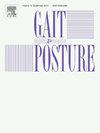A comparison of anticipatory processes between gait and step initiation: The role of the final state
IF 2.2
3区 医学
Q3 NEUROSCIENCES
引用次数: 0
Abstract
Background
Whole-body movement initiation with change of base of support is a common paradigm used to assess balance-movement coordination. During clinical evaluation, two transitions are commonly used: gait or step initiation. During their respective anticipatory periods, two mechanisms regulate the whole-body centre of mass acceleration: a shift in the centre of pressure (CoP); and modulation of internal whole-body angular momentum (). These transitions have different final states, and we do not know whether the two mechanisms are used similarly during the anticipatory period.
Research question
Is the final state already taken into account during the anticipatory period of a whole-body movement initiation?
Methods
We compared the time evolution of the CoP and in the sagittal plane during the anticipatory period of both gait and step initiation in 13 young, healthy participants.
Results
During gait initiation, we observed a larger backward CoP shift (31–56 % and 75–100 % of the anticipatory period), a larger forward-directed (45–68 %), and a lower backward-directed (84–100 %) compared to step initiation.
Significance
Our results show that mechanical instability is larger during gait initiation, while modulation is larger during step initiation. These findings suggest that the final state of a transition is taken into account during the anticipatory period. Based on our results, we suggest future research should use gait and step initiation to evaluate the generation of mechanical instability, and the use of free segments, respectively, in populations with balance deficits.
求助全文
约1分钟内获得全文
求助全文
来源期刊

Gait & posture
医学-神经科学
CiteScore
4.70
自引率
12.50%
发文量
616
审稿时长
6 months
期刊介绍:
Gait & Posture is a vehicle for the publication of up-to-date basic and clinical research on all aspects of locomotion and balance.
The topics covered include: Techniques for the measurement of gait and posture, and the standardization of results presentation; Studies of normal and pathological gait; Treatment of gait and postural abnormalities; Biomechanical and theoretical approaches to gait and posture; Mathematical models of joint and muscle mechanics; Neurological and musculoskeletal function in gait and posture; The evolution of upright posture and bipedal locomotion; Adaptations of carrying loads, walking on uneven surfaces, climbing stairs etc; spinal biomechanics only if they are directly related to gait and/or posture and are of general interest to our readers; The effect of aging and development on gait and posture; Psychological and cultural aspects of gait; Patient education.
 求助内容:
求助内容: 应助结果提醒方式:
应助结果提醒方式:


